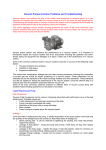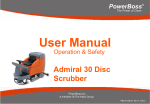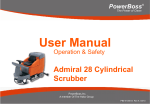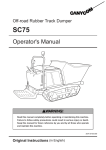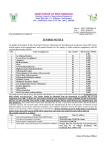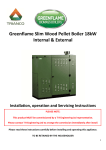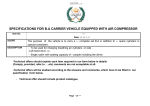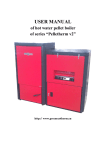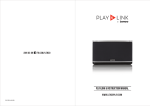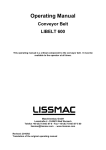Download Apex 49 - Sweeperland
Transcript
Apex 49 Model: PB40BL, PB40BH User Manual (Battery Version) Introduction Dear customer, It is our desire that the good characteristics of the Apex 49 should justify the confidence you demonstrated by making this purchase. Before first operation of your Apex 49 read these instructions carefully. The manual provides valuable information about operation, service and maintenance. Before first operation of the machine, read these instructions and safety information carefully and comply with them. Please be advised explicitly that we cannot accept any legal issues out of the contents of this manual. If repair work has to be performed make sure that only genuine spare parts are used; only genuine spare parts may guarantee a dependable machine. The symbol as used in this manual identifies items relevant to safety. Please observe the safety provisions (see chapter 1). Valid as of: 2 March 2007 Proper Use Proper Use The Apex 49 sweeper has been exclusively designed for collecting dry and moist matter from floor surfaces in e.g. factories, storage buildings, parking ground and pedestrian areas. Using the machine beyond this scope of application will be deemed improper use; The manufacturer cannot be held liable for consequential damages. The term of proper use also includes operation, maintenance and repair work to be performed in compliance with the manufacturer's specifications. The Apex 49 may be used by personnel only that are familiar with the machine and aware of possible hazards involved. The applicable Accident Prevention Regulations, Road Traffic Regulations, and aspects of safety and working medicine in vigour will have to be complied with. If modifications to the machine are made in absence of the manufacturer's prior consent, the latter cannot be held liable for damage resulting from such unauthorized modification. The machine has not been designed for collecting dusts which are detrimental to health or explosive. parts or accessories without prior and explicit consent or by non-compliance with the maintenance instructions. Notes on warranty Inspection The terms of the sales contract apply. Damages are not subject to warranty if they are due to non-compliance with the maintenance and service provisions. The maintenance work has to be performed by an authorized service center and confirmed in the "Maintenance certificate" which is the warranty document. The following is excluded from warranty: fuses, natural wear, damages caused by overload, inexpert handling and unauthorised modification of the machine. Moreover, any claim for warranty cannot be accepted if damages at the machine are caused by fitting Carefully unpack and inspect your Apex 49 for shipping damage. Follow unpacking instructions on shipping pallet. Each unit has been tested and thoroughly inspected before shipment. Any damage is the responsibility of the delivery carrier who should be notified immediately. 3 Contents Introduction/Proper Use Notes on Warranty Inspection 4 4.1 4.2 4.3 4.4 Operation . . . . . . . . . . . . . . . . . . . . .18 1 Safty Information . . . . . . . . . . . . .5 1.1 1.2 1.2.1 1.3 1.4 1.5 1.6 General Safety Information . . . . . . .5 Safety and Warning Symbols . . . . .6 Generally Applicable Symbols . . . .6 Labels at the Machine . . . . . . . . . .7 Operation/Safety Information . . . .10 Cleaning Informaton . . . . . . . . . . .11 Maintenance instructon . . . . . . . .12 4.5 4.5.1 4.5.2 4.5.3 4.5.4 4.5.5 Controls . . . . . . . . . . . . . . . . . . . .18 Control Panel . . . . . . . . . . . . . . . .20 Empty Dirt Hopper . . . . . . . . . . . .24 Empty Dirt Hopper Lift-Up Disposal . . . . . . . . . . . . . .24 Working with the machine . . . . . . .27 Switch Electro-Motor ON and OFF . . . . . . . . . . . . . . . . . . . . . . .27 Sweep . . . . . . . . . . . . . . . . . . . . . .28 Stop and Park . . . . . . . . . . . . . . . .28 Displace . . . . . . . . . . . . . . . . . . . .28 Transport . . . . . . . . . . . . . . . . . . .28 2 Description . . . . . . . . . . . . . . . . .14 5 Technical Data . . . . . . . . . . . . . . .29 2.1 2.2 2.3 2.4 2.5 2.6 2.7 2.8 2.9 2.10 Functional Descripton . . . . . . . . . .14 Cylinder Broom . . . . . . . . . . . . . . .15 Side Brush . . . . . . . . . . . . . . . . . .15 Filter System/Dust Evacuation . . .15 Shaking System . . . . . . . . . . . . . .15 Steering . . . . . . . . . . . . . . . . . . . .15 Wheels . . . . . . . . . . . . . . . . . . . . .15 Brake . . . . . . . . . . . . . . . . . . . . . .16 Travel Drive Assembly . . . . . . . . .16 Hydraulic System Lift-Up Disposal . . . . . . . . . . . . . . . . . . . .16 6 Maintenance/Service . . . . . . . . .33 3 First Operation . . . . . . . . . . . . . .17 3.1 3.2 First Operation of Batteries . . . . . .17 Insert Batteries . . . . . . . . . . . . . . .17 6.1 6.2 6.3 6.4 Maintenance Instruction . . . . . . . .33 Mount/Dismount Cylinder Broom .34 Adjust Sweeping Track . . . . . . . . .34 Sealing strips for Broom Compartment . . . . . . . . . . . . . . . .36 6.5 Folding Apron Adjustment . . . . . . .36 6.6 Replace Side Brush . . . . . . . . . . .37 6.7 Dismount Plate Filter . . . . . . . . . .38 6.8 Basic Cleaning of Plate Filter . . . .40 6.9 V-Belt Drive . . . . . . . . . . . . . . . . . .41 6.9.1 Replace Cylinder Broom V-Belt . .42 6.9.2 Replace Side Brush V-Belt . . . . . .42 6.9.3 Replace Suction Fan V-Belt . . . . .42 6.10 Adjust Steering Chain Tension . . .42 6.11 Check Hydraulic Fluid and Refill . .42 6.11.1 Check Hydraulic Fluid . . . . . . . . . .42 6.11.2 Refill Hydraulic Fluid . . . . . . . . . . .42 6.12 Electric System . . . . . . . . . . . . . . .43 6.13 Maintenance Schedule . . . . . . . . .44 7 4 Spare Parts . . . . . . . . . . . . . . . . .46 Safety Information 1 1.1 Safety Information General Safety Information Apart from the instructions contained in this manual, the general safety instructions and accident prevention regulations, as imposed by law will have to be complied with. Do not put the Manual aside without reading it even if you used similar sweepers before. Take the time to read them now and save time later. Machines with known defects must not be used. It will be of essence to make yourself familiar with all accessories and controls and their functions before you start working. Avoid the mess of having to read this book while trying to run the machine. Using the machine in areas with explosion hazard, on public roads and places is prohibited. The operator has to use the machine within its design limits. Shut the motors down before transporting the machine. Keep clear of hazard zone! Before commencing work, the operator has to make sure that the Apex 49 and its accessories are in proper and safe condition. Warning and instruction labels attached to the machine contain important information about safe operation. Illegible or lost labels have to be replaced. Provide for sufficient ventilation when sweeping indoors (dust and combustion gas). Pinching and shearing hazard. Provide for required safe distance before lifting or lowering the dirt hopper. Make sure that all covers are fitted before starting to sweep. 5 Safety Information 1.2 Safety and Warning Symbols 1.2.1Generally Applicable Symbols All paragraphs in this manual referring to your personal safety, the safety of your machine and the environment protection are attributed one of the following warning symbols: Symbol Hazardous for.... Description DANGER persons and goods dangerous situation caused by misuse inaccurate adherence of instructions or prescribed work routine the machine important information on handling the machine in order to maintain operability the environment due to use of substances representing an inherent danger to health of environment CAUTION Ecological hazard 6 Safety Information 1.3 Labels at the Machine The following safety and information signs are legibly attached to the machine. Missing or illegible stickers have to be replaced. Read and observe operator's Manual (7) Key switch (8) Brake (9) Folding apron (1) Noise power level (10) 82 dB (A) Parking brake (2) Nameplate Powerboss/Apex 49 (3/4/5) Fig.1 7 Safety Information 1.3 Labels at the Machine 24 V label (15) Battery charging (16) The label is located under the seat hood. Fig. 2 Safety and information signs 8 Rotating parts (14) Cylinder broom wearing take-up (12) Safety Information 1.3 Labels at the Machine Pinching hazard (6) (Lifted-Up Disposal) Hydraulic fluid (13) High-pressure cleaner (11) Do not clean by means of high pressure cleaner or vapour jet. 9 Safety Information 1.4 Operation/Safety Information Vacuum sweepers may be run by qualified personnel only; such personnel will have to have evidenced their qualification for running the machine to the owner or his authorized representative; operators explicitly will have to be instructed by the owner or his authorized representative to use the machine. The machine may be used for cleaning such surfaces approved by the owner or this authorised representative for operation of vacu um sweepers. Before starting the engine, switch off all drives Transporting persons on the machine is prohibited. Ride-on machine types are to be started with the driver being seated. 10 Never leave the machine unattended before the motors are off and the machine is protected against unintended movements. To prevent the machine from unauthorized use, pull the control key to block all drives. Shut down the motors before transport of the machine. The driver has to take account of local conditions and when operating the sweeper he has to watch out for other persons, especially children. Do not open hood or fairings with the machine running. This machine must not be used as dust-evacuating machine with dust filter insert (separator) to collect dusts which are hazardous to health. Compared to four-wheeled vehicles, driving stability of three-wheeled vehicles is reduced. We thus recommend: - do not negotiate curves at high speed. - do not turn at slopes but on level ground only - ride up- or downhill straight. Safety Information Warning and instruction labels attached to the machine contain important information about safe operation Provide for sufficient ventilation when sweeping indoors (dust and combustion gas). Proceed to filter shaking only if the dirt hopper is in closed position. 1.5 Cleaning Information The machine is splash-proof (IPX3). Do not clean the SW5X by means of high pressure cleaner or vapour jet. Proceed to cleaning of the dirt hopper in regular intervals to preclude formation of bacterial deposits. 11 Safety Information 1.6 Maintenance Instructions A good approach to prevention of accidents is proper maintenance of the machine. Before proceeding to repair or maintenance work remove the key. Use appropriate tools for maintenance, service, setting etc. As far as aspects of safety are concerned, spare parts will have to be at least of the same quality as the genuine spare parts. Switch off the motors before maintaining the machine or replacing parts of it. Turn off the machine and pull the key and additionally, disconnect the battery plug. Check hydraulic hoses and lines for leakage or damages in regular intervals. Replace defective hoses and lines immediately. 12 Before changing wheels protect the machine against rolling by placing wedges. Proceed to wheel changing when the machine is on level and solid ground. Do not repair the pneumatic tires mounted to the machine yourself. Dismount the wheel and take it to repair to a tire workshop. Use of other than the cylinder brooms and side brushes approved by the manufacturer is not acceptable (see technical data) since use of other cylinder brooms and side brushes may affect your safety. When handling lubricating agents, the applicable regulations for protection of the environment and prevention of fire have to be complied with. Provide for disposal of used oil and grease in accordance with the provisions imposed by law. Collect cleaning agents, oil, fuel oil, grease etc. and provide for adequate disposal. Wipe away spilled substances. Safety Information Before commencing any work on the electric system disconnect battery (neg. lead) of the Apex 49 and pull the ignition key. Open the hood before charging batteries; explosive gases may occur during the charging procedure. Do not keep batteries discharged for a longer period; always recharge them as soon as possible. Keep batteries dry and clean and clear of soiling such as e.g. metallic dust to avoid leakage current. Top with distilled water only. Never refill battery acid in battery cells of perfect condition. Do not place metal objects or tools onto batteries. Short-circuit and deflagration hazard. Battery acid is highly caustic (keep clear of children). When checking the battery acid level, wear safety glasses. If acid splashes get into the eyes rinse with clear water for 15 minutes and contact a doctor immediately. Use appropriate protective means (e.g. protective gloves or finger-stalls) when handling battery acid. Do not use open flames (explosion hazard). Spilled (straight) battery acid must not get into the sewage system before having been neutralised. Comply with the regulations imposed by law and observe local provisions. Do not eat, smoke or drink in rooms where batteries are charged to avoid damaging your health. After work with batteries wash your hands thoroughly. Provide for sufficient ventilation. 13 Description 2 The side brush is used to collect dirt at borders and to enlarge the working width as well as to increase the area performance on large surfaces. The cylinder broom casts the debris overhead into the dirt hopper. The collected fine dust is evacuated by the suction fan and separated by a filter system. The air returned into the environment is clean. Description 2.1 Functional Description Fig.4 Principle Model: PB40BH Fig.3 Principle Model: PB40BL 14 Description 2.2 Cylinder Broom The cylinder broom is equipped with 12 rows of bristles arranged in V-shape. The cylinder broom width amounts to 27.6 in. (700mm) and its diameter to 13.6 in. (345mm). 2.3 Side Brush At the standard version, the side brush is located at the front right of the machine. The operator lifts and lowers it by hand lever. The side brush has a light inclination. The swinging area of the side brush arm is limited by stop screws. The side brush is driven by V-belt. For special application, fitting of a second side brush at the left is possible. 2.4 Filter System / Dust Evacuation The filter system is located in the filter case above the dirt hopper. The suction fan transports the fine dust raised by the cylinder broom to the plate filter where it is separated. The fine dusts sets at the outsides of the filter blades. 2.6 Steering Steering is controlled mechanically from steering wheel to front wheel via chain. This chain is to be re-adjusted as required. 2.7 Wheels Front wheel: solid rubber tires Rear wheels: solid rubber tires In case of heavy dust development, check and clean the plate filter at regular intervals. 2.5 Shaking System Due to normal working vibration the set dust partly falls off into the dirt hoper. To ensure working in a dustfree environment, however, actuate the shaking system regularly, or after request by the pilot lamp at the latest. 15 Description 2.8 Brake The Apex 49 is equipped with a service brake. This brake has been constructed as shoe brake and equally serves as parking brake. It is located in the rear wheels and is actuated via cables. A special adjustment screw is situated at the right-hand rear wheel. Any work at the braking system has to be executed by qualified persons in a qualified workshop only. 2.9 Traction Drive Assembly The Apex 49 is equipped with an electric drive assembly with continuous regulation. 2.11 Battery Systems Battery Charging Status Indicator Before commencing any work on the electric system disconnect the battery plug. Do not use open flames when handling batteries and especially when checking the battery acid level. Provide for sufficient ventilation in rooms where batteries are charged. Spilled (straight) battery acid must not get into the sewage system before having been neutralised. Comply with the regulations imposed by law and observe local provisions. Open the hood before charging batteries; explosive gases may occur during the charging procedure 2.11.1 Low Discharge Signal Sender Setting Other Battery Types Have the low discharge signal sender set to other battery types by qualified personnel only and in approved qualified workshops only. 2.10 Hydraulic System (Lift-Up Disposal) The hydraulic system comprises a compact unit (hydraulic pump with hydraulic tank), the hydraulic hoses and a hydraulic cylinder. Hydraulic fluid: Mobil oil DTE 15 M The named hydraulic fluid has been filled in the hydraulic system in the factory. Filling of hydraulic tank: 0.2 gal. (0.76 litre). 2.11.2 Hourmeter The operating hours of the machine appear in the display (Fig. 5/2); the hourmeter will count only during working or transport ride; only full hours are displayed). Fig. 5 16 Upon turning ON by key switch, battery charging status is shown by display of green bars (Fig. 5/1). As the battery discharges during operation, the lighting green bars extinguish one after another showing thus always the current charge status of battery charge. Flashing of the last two green bars indicates that operation will be stopped soon. In order to preclude low discharge of batteries, the sweeping units are switched off and riding speed reduced to 50% if battery is discharged. The red LED (Fig. 5/4) than flashes. First Operation 3 First Operation 3.2 Insert Batteries If the battery type setting at the LDS should be incorrect, have the setting modified by qualified personnel in an approved workshop. The Apex 49 has been extensively tested and submitted to a functional check before delivery. Only qualified personnel of your local contract dealer are allowed to proceed to first operation. After shipping of the machine, we advise your contract dealer. He will contact you to make a date for briefing lessons. Use admitted lifting and transport devices. Make sure that lifting hooks do not damage cells, connectors or connecting cables. 3.1 First Operation of Batteries To achieve the optimum performance and a maximum service life, the batteries must be given the initial charge after filling. Handling and function of the battery charger is described in detail in the instruction manual supplied with each charger unit. Since batteries and charger units are matched, we recommend using batteries and chargers as prescribed by Minuteman. We can grant full warranty only if those units are being used. Do not use the Apex 49 at ambient temperatures of more than 105°F (40°C). Do not start the machine at temperatures of 32°F (0°C) or less. Fig.5a - Turn machine off and pull key. - Secure machine by actuating parking brake. - Fold up seat hood - Insert battery - Connect charging plug of the battery connection cable and cable of the charger unit and proceed to initial charging. - After charging of the batteries, connect charger plug (Fig.5b/2) and device plug for electrical connection. Fig.5b 17 Operation 4 Operation 4.1 Controls 1 2 3 4 5 6 7 Actuator for folding apron Service brake lock Service brake/parking brake pedal Drive pedal, reverse Drive pedal, forward Control panel Seat adjustment Fig.6 18 Operation 1 Actuator for folding apron to open and close the folding apron for collecting coarse dirt. 2 Service brake/parking brake lock to lock the service brake/parking brake. If locked, the service brake works as parking brake. Release the lock by depressing the service brake pedal. 3 Service brake/parking brake pedal to actuate the service brake at the rear wheels. Before leaving the machine unattended, engage the service brake and lock. 4 Drive pedal, reverse to change direction to reverse ride with continuous regulation of riding speed at the same time. If the driver releases the pedal it returns to initial position and the machine slows down to standstill. 5 Drive pedal, forward to change direction to forward ride with continuous regulation of riding speed at the same time. If the driver releases the pedal it returns to initial position and the machine slows down to standstill. 6 Control panel Refer to chapter "Control panel" 7 Seat adjustment to adjust the seat position to drivers of different height. Adjust the seat so as to allow the driver being comfortably seated and attaining all elements required for operation. - Adjust seat lengthwise: push lever slightly to the right and displace seat forwards or backwards to the required position. Then let the lever catch again. 19 Operation 4.2 Control Panel 1 Cylinder broom lever 2 Release of lifted-up disposal function 3 Horn 4 TSG 5 Suction fan/shaking system knob 6 Flashlight (option) 7 Lighting (option) 8 Lift and lower (Lift-Up Disposal) 9 Side brush lever 10 Pilot lamp, parking brake 11 Battery charge status indicator/ Hourmeter 12 Pilot lamp, fan 13 Pilot lamp, shaking system 14 Key switch Fig.7 20 Operation 1 Cylinder broom lever to lift and lower as well as to switch on and off the cylinder broom and the side brush. - Lower cylinder broom as well as switch on cylinder broom and side brush = push lever - Lift cylinder broom as well as switch off cylinder broom and side brush = pull lever 2 Release for lifted-up disposal function to release the lifted-up disposal function for lowering of lifting. Has to be actuated before pressing the key for lifting/lowering lifted-up disposal function. Hold the key during lifting/lowering. Before changing lifting to lowering or vice versa, the "Release Lifted-Up Disposal" key has to be released once and pressed again 3 Horn An acoustic signal sounds upon actuation of this button. 4 Cover with plug connection for battery/LDS programming Remove this cover to modify setting of battery type. The plugged connections of the programming cable are located there. Have the programming executed by a contract dealer with qualified personnel at hand. 21 Operation After jolting, the knob is to be kept in position 1 for about 10 seconds (to optimize the cleaning result in case of heavy fine dust load). 5 Suction fan/shaking system knob If the yellow pilot lamp (Fig. 7/13) lights, actuate the shaking system (position 2). In this position, the shaking system is operable and proceeds to jolting in 7 repeated intervals. Knob position (from bottom to top position): Pos. 0 Activated vacuuming function (close flap before sweeping dry surfaces or collecting dry dirt). 6 Flashlight (option) to switch the flashlight ON/OFF. Pos. 1 Deactivated vacuuming function (open flap before sweeping wet surfaces and collecting wet dirt). Pos. 2 Shaking system ON (pull knob to stop and then release) 7 Lighting (option) to switch the driving headlight ON/OFF. 22 Operation 8 Lift and lower (lifted-up disposal) to lift and lower the dirt hopper. Lift the dirt hopper by pressing the key until the desired height for lifting-out is attained. When lowering the dirt hopper make sure to hold the key pressed until the hopper has contact with the frame. 10 Pilot lamp, parking brake (red) lights upon actuation of the parking brake Extinguishes upon release of the parking brake. 11 Battery Charging Status Indicator Refer to paragraph 2.11 Hourmeter Refer to paragraph 2.11 Actuate release key for lifted-up disposal and hold before lifting or lowering. 13 Pilot lamp, shaking system (yellow) Proceed to jolting of the filter system upon lighting of this pilot lamp by actuating the knob (Fig.7/5). The pilot lamp flashes during the shaking procedure and extinguishes after filter has been cleaned. Jolting is effectuated in 7 intervals. 12 Pilot lamp, suction fan (orange) lights if the suction fan is not activated. 9 Side brush lever to lift and lower the side brush. - Lower side brush 14 Key switch to switch ignition on and off, to start and stop engine and to secure it against unauthorised use. = push lever - Lift side brush = pull lever 23 Operation 4.3 Empty Hopper - Fold bow (Fig. 8/3) up = the dirt hoppers (Fig. 8/2) are lowered. - Use the recessed grip (Fig. 8/1) of one of the hoppers to lift it lightly and extract it. - Take the hopper at its bow-type handle to disposal and empty. - Empty second hopper as described above. - Re-insert hopper (Fig. 8/2) and fold down the bow (Fig. 8/3). 1 Recessed grip in hopper 2 Dirt hopper 3 Bow to lift/lower dirt hoppers Clean hoppers at regular intervals. 4.4 Empty Hopper (Lift-Up Disposal) Lift side brush and cylinder broom before emptying of the hoppers. Broom and fan will be autmatically switched ON upon lowering of the hopper if cylinder broom has been ON before lifting. Fig.8 24 The driving speed forward and backwards with dug turning property container is reduced to 50 %, the turning roller is switched off. Fig.9 1 2 3 4 Lift-out arm Lift-out cylinder Hopper Bow-type handle Clean hopper at regular intervals. Operation Lift side brush and cylinder broom before removal of the dirt hopper. Pinching and shearing hazard. Provide for required safe distance before lifting or lowering the hopper. Riding with the lifted hopper reduces stability of the machine significantly. For this reason, do not lift the hopper but just before emptying. Before lifting the hopper, the operator has to make sure that no persons or objects are behind or next to the machine. Stop the machine on level ground before lifting the hopper. Proceed to emptying of the hopper as follows: - When the hopper is lifted, the operator has to ride the machine slowly. Fig.10 Lift and switch off side brush and cylinder broom Proceed to shaking of the filter system Actuate switch (Fig. 10/1) and hold (hopper is released) Actuate switch (Fig. 10/2) by pushing = lift hopper Hopper (Fig. 9/3) is lifted-out Back the Apex 49 until the hopper is positioned above the container for disposal. Pull the safety knob (Fig. 11/1) of the release lever (Fig. 11/2). Release swinging of the hopper by release lever (Fig. 11/2). Forward the Apex 49 after emptying. Lower hopper by actuating switch (Fig. 10/1) and switch (Fig. 10/2); pull lever = lower hopper Control panel (Lift-Up Disposal) Keep clear of the hazard zone! 1 Release switch for lifted-up disposal function 2 Hopper, lift and lower 25 Operation Should the hopper not be completely emptied after swinging, proceed to manual shaking with the handle (Fig. 9/4). Observe the information given in paragraph 4.2 on releasing of lifted-up disposal. Sweeping is possible only after the hopper has attained its working position. Clean the hopper in regular intervals. Lifted-up disposal function is blocked as long as sweeping function is ON. Fig.11 Release lever, swing hopper 1 Safety knob 2 Release lever, swing hopper 26 The hopper is approved only for a max. filling of 18.5 gal (70 litres) but not more than a weight of 242.5 lb (110 kg). Operation 4.5 Working with the machine 4.5.1 Switch Electro-Motor ON and OFF The driver is requested to carefully read this manual. All controls are marked with easy-to-understand symbols that ease familiarization. First driving attempts should be limited to clear areas until you are familiar with all controls and their functions. Please comply with the following safety provisions: When working with the Apex 49 all safety measures generally applicable for handling vehicles have to be observed. No passenger transport is admitted with the Apex 49. Warning and in- struction labels attached to the machine contain important information about safe operation and guarantee your personal safety. Before commencing work, the operator has to make sure that the machine and its accessories are in proper and safe condition and comply with the provision for safety at work. Do not operate the Apex 49 without protective devices. For safety reasons, the Apex 49 is equipped with a seat contact switch. Starting the motor or running the motor is possible only when the driver is seated. If the seat contact switch is activated with the electromotor running, reset by turning the key switch OFF and ON again. Switch all levers and switches to neutral position. Actuate parking brake Turn key switch to "I" Check the drive pedal for being in neutral position before switching ON. If the Apex 49 is not used within the admissible conditions and environments of use, the protective functions may respond and switch off driving function without prior warning. Slow the machine down to standstill by the service brake in that case. Acknowledge protective function by key switch. Overheating of the travel drive assembly or control module always entails a cooling phase. The seat contact switch deactivated all functions, driving function included. Slow the machine down to standstill by the service brake in that case. 27 Operation 4.5.2 Sweep 4.5.4 - Lower cylinder broom. - Release parking brake. - Slowly depress drive pedal until desired speed has been attained. - Regularly actuate shaking device to clean plate filter. - Check filling level of the hopper and empty if required. Make sure that the key switch is in neutral position and the side brush and cylinder broom are lifted up before displacement of the machine. 4.5.3 Stop and Park - Release drive pedal which returns automatically into its neutral position and the machine slows down to standstill. - Actuate parking brake - Lift side brush and cylinder broom - Turn key switch to "0" When leaving the machine unattended, pull key in order to preclude unauthorized use. 28 Displace 4.5.5 Transport Before transporting the machine on other vehicles, engage the parking brake and secure the machine by straps and by placing wedges at the wheels. Technical Data 5 Technical Data Apex 49 Dimensions and weights Length with side brush Width without side brush Width with 1 side brush Width with 2 side brushes Height above driver's seat Max weight including accessories Admissible total weight Driving and sweeping performance Forward speed Reverse speed Sweeping speed up to (4 km/h recommended) Sweeping track without side brushes - with 1 side brush - with 2 side brushes Theoretical sweeping perf. without side brushes - with 1 side brush - with 2 side brushes Gradability, max. Apex 49(Lift-Up Disp.) in. (mm) in. (mm) in. (mm) in. (mm) in. (mm) lb (kg) lb (kg) 59.8 (1520) 39.4 (1000) 44.1 (1120) 48.8 (1240) 51.2 (1300) 1323 (600) 1742 (790) 59.8 (1520) 39.4 (1000) 44.1 (1120) 48.8 (1240) 51.2 (1300) 1367 (620) 1830 (830) mph (km/h) mph (km/h) mph (km/h) in. (mm) in. (mm) in. (mm) sq. ft./h (m² / h) sq. ft./h (m² / h) sq. ft./h (m² / h) % 3.7 (6,0) 2.5 (4,0) 3.7 (6,0) 27.6 (700) 28.2 (970) 48.8 (1240 45210(4200) 62430(5800) 80190(7450) 16 3.7 (6,0) 2.5 (4,0) 3.7 (6,0) 27.6 (700) 28.2 (970) 48.8 (1240 45210(4200) 62430(5800) 80190(7450) 16 29 Technical Data Apex 49 Filter system Filtering surface Hopper filter Cylinder broom Length Diameter Wearing limit Speed Sweeping track Quantity of bristle rows Serial bristling Ground clearance of Rubber Skirts at broom compartment Rubber Skirts - left - right - rear Skirt front Side brushes Diameter Speed Serial bristling Hopper Hopper capacity 30 Apex 49 Lift-Up Disp. sq. ft. (m²) piece 30.1 (2,8) 1 30.1 (2,8) 1 in. (mm) in. (mm) in. (mm) rpm in. (mm) 27.6 (700) 13.6 (345) 11.4 (290) 530 +/- 20 2.0 + 0.2 (50+5) 12 v-shape PES 27.6 (700) 13.6 (345) 11.4 (290) 530 +/- 20 2.0 + 0.2 (50+5) 12 v-shape PES in. (mm) in. (mm) in. (mm) 0.04 (1) 0.04 (1) 0.16 (4) 0.04 (1) 0.04 (1) 0.16 (4) in. (mm) rpm 460 90 PES 460 90 PES gal (l) 2x7.9 (2x30) 18.5 (70) Technical Data Apex 49 Tires Front drive wheel, bandage Rear, solid rubber tires Electric drive Service voltage Travel drive assembly (P2/P1) Suction fan motor/sweeping (P2/P1) Total power consumption (P1) Apex 49(Lift-Up Disp.) in. (mm) in. 11.81 (300/90) 4.00 - 4 11.81 (300/90) 4.00 - 4 DC/V KW KW KW 24 0.8/1.0 1.0/1.25 2.4 24 0.8/1.0 1.0/1.25 2.4 Hydraulic system Compact unit (maintenance-free) Voltage V DTE 15 M or equivalent Hydraulic fluid, e.g. Hydraulic tank, capacity 24 gal (l) 0.2 (0,76) 31 Technical Data Noise emission The sound pressure level measured according to DIN EN ISO 11201 and under standard operating conditions at the operator's ear with - operating status - fan, cylinder broom and side brush ON amounts to dB (A) 70 The sound power level measured according to DIN EN ISO 3744 under standard operating conditions and maximum volume flow amounts to dB (A) 82 Vibrations The frequency weighted acceleration measured according to EN 1003 which have an effect upon the upper limbs (hand-arm-system) amounts under normal working conditions ft./s2 (m/s2) < 8.07 (< 2,5) The frequency weighted acceleration measured according to EN 1032 which have an effect upon the lower limbs (feet and seat) amounts under normal working conditions ft./s2 (m/s2) < 1.64 (< 0,5) 32 Maintenance/Service 6 Maintenance/Service 6.1 Maintenance Instructions Compliance with our recommendations concerning maintenance work will give you the certitude of having an effective and dependable machine at your disposal. It is better to take precautions than repairing damages - and it saves money! The Apex 49 has to be inspected for safe condition by an authorized expert as required, but not less than once a year. Results of such an inspection have to be kept on file at least until the next inspection is performed. Please contact your local distributor if you cannot do the maintenance works as prescribed in the maintenance schedule in-house. He will have these works done for you and has qualified personnel and genuine spare parts at disposal. When cleaning or servicing the machine, or replacing parts, have the motors stopped and the key removed, the negative battery pole disconnected and the service brake (parking brake) engaged. In case of questions or orders for spare parts, please always quote your machine's serial indicated on the nameplate Refer to chapter 1.3.1 Fig. 2/12 for position of nameplate. Collect spilled oil and provide for adequate disposal. Use appropriate tools for servicing, maintenance and adjusting work only. Spare parts at least will have to be of the same quality as genuine parts are. Do not remove or install tires or repair a rim. Take the wheel and rim to a workshop where qualified personnel and the required specific tools are available. When working at the electric system disconnect the negative pole of the battery. 33 Maintenance/Service 6.2 Mount/Dismount Cylinder Broom The cylinder broom is accessible from the left side of the machine and is to be dismounted as follows: - Open locks (Fig. 14/2) by enclosed square spanner (turn counter-clockwise) - Remove cover (Fig. 14/1) - Lower cylinder broom - Pull ignition key and protect by engaging parking brake - Remove cover - Turn handle (Fig. 15/3 +5) upwards and unlock - Remove plate with sealing strip (Fig. 15/4) - Remove cylinder broom by pulling. For mounting the cylinder broom proceed in inverse order. 6.3 Adjust Sweeping Track An adjustment device allows adaptation to different sweeping conditions. The cylinder broom has to be adjusted for normal use and with regard to a low degree of wearing as described in the following. Check the broom adjustment on level ground as follows. Fig.15 Dismount cylinder broom Remove cover 34 Fig.14 - Loosen star-shaped knob (Fig. 15/2) and remove - Remove cylinder broom seating (Fig. 15/1) Maintenance/Service With one full turn of the knob, the track widens or broadens by approx. 0.4 in. (10 mm) Before checking: Mark level surface for checking broom adjustment by chalk. When exceeding the sweeping track width the cylinder broom wearing increases as well as the load of the drive. - Secure machine by engaging parking brake. - Lower cylinder broom and let it run dry. - Lift cylinder broom and forward the Apex 49 a bit. With the correct broom adjustment the parallel sweeping marks have to appear on the floor (sweeping track). The sweeping track width is to be 1.97 in. (50mm) with the Apex 49 The sweeping track width can be adjusted at the star-shaped knob (Fig. 15/2) as follows: Broom adjustment Fig.16 - Stop engine and pull key Engage parking brake Open seat hood Loosen handle (Fig. 16/3) Turn star-shaped knob (Fig. 16/1) to the left = wider sweeping track to the right = smaller sweeping track - Fix handle (Fig. 16/3) - Broom adjustment sticker (Fig. 16/2) Fig.17 Fig. 17 Broom adjustment sticker (in Fig. 17/2) 35 Maintenance/Service 6.4 Rubber skirts for Broom Compartment In order to assure good function of the sweeper, excellant maintenance of the skirts is required, especially in order to attain the prescribed low pressure in the broom compartment, a clean sweeping result and the less possible wear of the skirts (check the Rubber skirts @ the broom compartment for wear and damage in regular intervals). Replace defective skirts. The ground clearance of the lateral and rear skirts is adjustable via (oblong holes in the skirts). Ground clearance sides: approx. 0.04 in. (1mm) rear: approx. 0.16 in. (4mm) Height of the front skirt (folding apron) cannot be adjusted. Being dragged, it has contact with the floor. 36 6.5 Folding Apron Adjustment - Remove bolt (Fig. 18/2). - Modify adjustment by turning the fork head (Fig. 18/1). Modify adjustment such that the cylinder broom does not retract the sealing strip of the folding apron during operation. Fig.18 Adjust folding apron - Turn engine off and pull key - Secure machine by engaging parking brake - Remove cover (as described in the paragraph "Mount/Dismount Cylinder Broom"). Maintenance/Service Proceed in inverse order for mounting of the side brush. 6.6 Replace Side Brush The side brush is located at the front right of the machine (standard version). Use the lever (paragraph 4.2, Fig. 7/9) to lift and lower the side brush. The side brush is to be lightly inclined in forward and in outward direction. The swinging area of the side brush arm is limited by stop screws. The side brush is driven by a V-belt. Fitting of a second side brush for specific appliances is possible. Proceed as follows for dismounting of the side brush: Replace side brush Fig.19 - Turn engine off and pull key. - Secure machine by engaging parking brake - Disconnect battery plug - Side brush lifted - Loosen hexagonal nut (Fig. 19/1) und remove together with washer - Remove screw (Fig. 19/2) - Remove side brush 37 Maintenance/Service 6.7 Dismount Plate Filter Proceed as follows for dismounting of the plate filter: - Turn engine off and pull key. - Secure machine by engaging parking brake - Disconnect battery plug - Open seat hood - Open quick-release locks (Fig. 20/1) - Remove cover, filter case (Fig. 20/2) - Loosen wing screws (Fig. 21/2) and remove. - Fold back frame with electric-motor (Fig. 21/3). - Hook frame at indicated position (Fig. 21/4) - Remove plate filter (Fig. 21/5). For mounting of plate filter proceed in inverse order. 38 Fig.20 Dismount plate filter 1 Quick-release locks 2 Cover of filter case 3 Filter case Maintenance/Service Fig.21 Hopper filter 1 2 3 4 5 Detent hook Wing screws Frame with electric-motor Opening for detent lever Hopper filter 39 Maintenance/Service 6.8 Basic Cleaning of Hopper Filter Hold the Hopper filter (Fig. 22/1) in vertical position and drop it from a height of approx. 3 ft. (1 m) to the even floor as represented in Fig. 22. The dirty side of the filter points to the bottom. Soiled side Clearance approx. 3ft. (1 m) Floor Fig.22 Basic cleaning of Hopper filter 1. Hopper filter 40 Maintenance/Service 6.9 V-Belt Drive 1 2 3 4 5 6 7 8 9 10 11 12 13 Tension roller Suction fan V-belt (20Hz) V-belt pulley V-belt for cylinder broom and side brush (130Hz) Side brush V-belt Belt pulley Cylinder broom V-belt Tension roller lever Belt pulley Tension spring Hexagonal nut Hexagon socket screw Screws V-belt drive Fig.24 41 Maintenance/Service 6.9.1 Replace Cylinder Broom VBelt - Turn engine off and pull key. - Secure machine by engaging parking brake. - Disconnect battery plug - Detent tensioning spring (Fig. 24/10) by left hand while taking the V-belt off the tensioning roller with right hand. - Remove V-belt (Fig. 24/7). Proceed in inverse order for mounting. 6.9.2 Replace Side Brush V-Belt - Turn engine off and pull key. - Secure machine by engaging parking brake - Disconnect battery plug - Remove bottom right cover (turn locks counter-clockwise by square spanner). - Remove cylinder broom V-belt (as described in paragraph "Replace Cylinder Broom V-Belt") - Loosen screws (Fig. 24/13) at the cover plate and remove - Remove cover plate - Push side brush from the front side in direction of the machine to detent V-belt (Fig. 24/5) - Remove V-belt (Fig. 24/5) Proceed in inverse order for mounting. 6.9.3 Replace Suction Fan V-Belt - Turn engine off and pull key. - Secure machine by engaging parking brake - Open seat hood - Disconnect battery plug - Open quick-release locks (Fig.21/1) - Remove filter case cover (Fig.21/3) - Loosen screws at the inside of the right lateral fairing and remove. - Tilt lateral fairing lightly to the outside, the remove by pulling upwards. - Loosen tensioning roller (Fig. 24/1) - Loosen hexagonal nuts (Fig. 24/11) and hexagon socket screw (Fig.24/12).and detent V-belt (Fig.24/4) - Remove V-belt (Fig.24/4) from Vbelt pulley (Fig.24/3). - Remove V-belt (Fig.24/2). Proceed in inverse order for mounting. Do not exceed tension of V-belt. Observe the following when mounting the V-belt: First adjust tension of V-belt (fig.24/4), then adjust tension of V-belt (fig.24/2). 6.10 Adjust Steering Chain Tension Check the condition and function of steering chain every 200 hours of operation. Proceed to adjustment of tension via a spring located in the pedal area and accessible after removal of the cover plate. We recommend having this adjustment work done by qualified personnel only. Adjust tension of the steering chain such that rotational movement is possible without jerks. 42 6.11 Check Hydraulic Fluid and Refill Fig.25 6.11.1 Check Hydraulic Fluid - Turn engine off and pull key - Secure machine by engaging parking brake - Open seat hood - Check hydraulic fluid level at tank (Fig. 25/1), the level must not fall below the minimum mark (Fig. 25/2). It should read between minimum (Fig. 25/2) and maximum mark (Fig. 25/3). 6.11.2 Refill Hydraulic Fluid - Remove cover (Fig. 24/4) and refill hydraulic fluid - Close hydraulic fluid tank with cover Use DTE 15M hydraulic fluid or a fluid of similar quality. Maintenance/Service 6.12 Electric System 1 F2 Pre-fuse (20A) 2 F3 Engine shutdown, hourmeter (5A) 3 F4 Indicators control panel, jolter controlling, (front right lighting option, right rear light (5A) 4 F5 Horn (10A) 5 F7 LPG equipment option (10A) 6 F8 Front left lighting option, left rear light (7.5A) 7 F9 Lifted-up disposal control (7.5A) 8 F10 LPG equipment option (10A) 9 F11 Shaker motor (30A) 10 F12 Generator charge status indicator (5A) 11 F14 light option (5A) 12 LPG option control unit 13 K6 Relay, (Lift-Up disposal) 14 K7 Relay, (Lift-Up disposal) 15 K8 Relay, (Lift-Up disposal) 16 K9 Relay, (Lift-Up disposal) 17 K10 Relay, (Lift-Up disposal) 18 K11 Relay, lower hopper 19 K3 Relay 20 K4 Relay, filter monitoring 21 K5 Relay, impulse relay shaker 22 F13 Hydraulic unit for (Lift-Up disposal) 30A Fig. 25 43 Maintenance/Service 6.13 Maintenance Schedule Check battery acid level and top with distilled water if required (with fully charged battery only) Check acid density of battery Daily after first hours of operation every 100 every 200 X X Clean battery poles and grease Check cables for damages and screwed connections for tight fit Check function of seat contact switch X Visual check of front tires X Check cylinder broom for wear & foreign particles (e.g. wire, straps) and replace broom if required X X X Check sweeping track and adjust if required Check rubber skirts at the broom compartment, adjust if required or replace defective skirts Check skirts at hopper, replace defective skirts Check side brush adjustment and brush bristles for wear, adjust if required or replace side brush Check V-belt for wear and correct tension readjust if required 44 X X X X 5 X every 300 Maintenance/Service 6.13 Maintenance Schedule Visual check of V-belts Daily after first Hours of operation every 100 every 200 X Check service/parking brake and readjust if required X Check filter system for tightness (visual check) X Dismount hopper filter and clean if require X Clean travel drive assembly, brush drive, shaker moto X Check tread of tires Check function of electric-motor, carbon brushes for smooth operation and wear; clean motor from carbon dust and replace carbon brushes if required Check carbon brushes of travel drive assembly (to be executed by qualified personnel only) X 50 X 500 X Check hydraulic hoses and replace if required X Check hydraulic fluid level for lifted-up disposal and refill if required Check tension of fixing screws for lifted-up disposal facility and re-tighten if required 36 lb. ft. (49 Nm) Check tension of steering chain and readjust tension if required every 300 X 5 X X 45













































